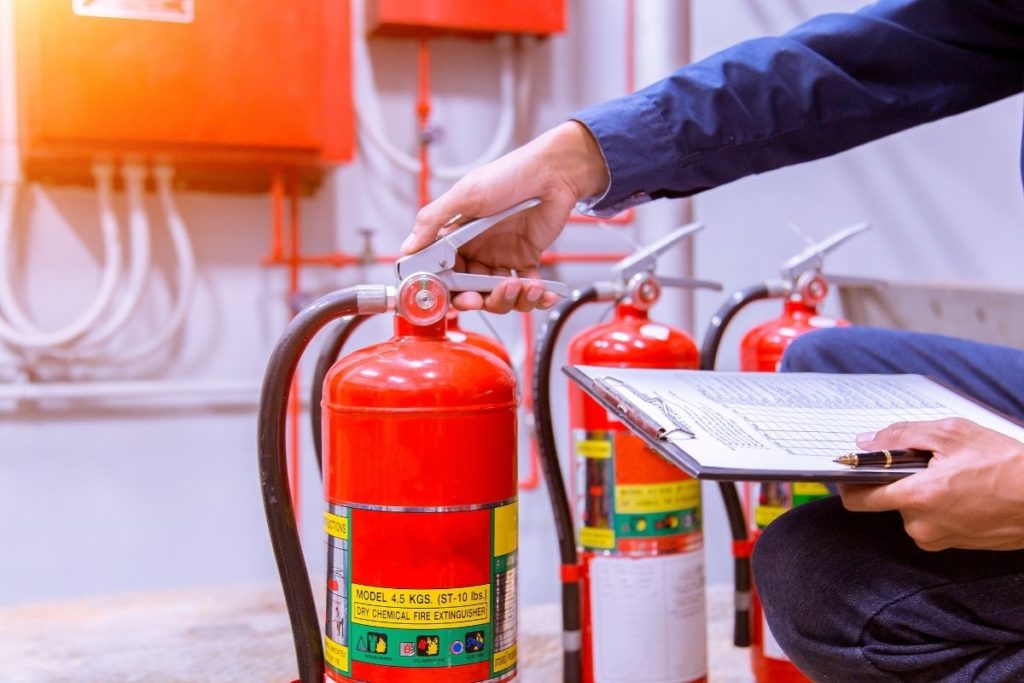Learn More About Fire Extinguisher Regulations on Construction Sites

Construction sites can be hazardous environments and have a higher risk of fires. Since construction can sometimes take months and builders won’t have the luxury of sprinkler systems, OSHA requires fire extinguishers to be on-site at all times. Construction phase plans must account for the location of fire extinguishers all over the site.
The main concern is not if a company has firefighting equipment available – it’s where they’re located and how many there are. This article will cover what OSHA regulations require for construction sites as well as other considerations for suitable fire extinguishers for the safety of the site.
What fire extinguishers do I need on a construction site?
Different types of fire extinguishers are suitable for various hazards. If you’re unsure which type to use, refer to the National Fire Protection Association (NFPA) or your local code requirements. The following is a list of general classifications for areas on construction sites:
Class A – Ordinary combustibles such as paper and wood; water will put it out but also spreads the flames; suitable for electrical fires in this classification due to lack of flammable liquids/gasses involved.
Class B – Flammable liquids like gasoline, oil, etc., with no specific need for foam suppression capabilities, therefore suitable for both chemical and standard Type ABC dry chemical powder unitary system units.
Class C – Electric equipment fires, suitable for both chemical and standard Type ABC dry chemical powder unitary system units.
OSHA has a construction hazard communication rule that requires a site plan to be submitted with the building permit application. The required elements of this plan involve all fire extinguishers on-site and their location, and how they’re going to be used in an emergency situation. The NFPA suggested method is to show each type of class by labeling the extinguisher. Letter designation should be used next to the fire extinguishers nameplate information, like “(A),” meaning it’s suitable for Class A hazards only. If no letter is shown, then use all available types for general areas.
What does OSHA require for companies that have fire extinguishers?
OSHA has a code of regulations that all companies need to adhere to regarding fire extinguishers. They have to be suitable for their specific environment, and they must also be in compliance with codes. In the construction phase plan, there is a requirement for an appropriate fire extinguisher in each construction site or building under construction.
1926.150(c)(1)(i): “A fire extinguisher, rated no less than 2A, shall be provided for every 3,000 square feet of the protected building area, or major fraction thereof. Travel distance from any point of the protected area to the nearest fire extinguisher shall not exceed 100 feet.”
1926.150(a)(4): “All firefighting equipment shall be periodically inspected and maintained in operating condition. Defective equipment shall be immediately replaced.”
1926.150(c)(1)(vi): “A fire extinguisher, rated not less than 10B, shall be provided within 50 feet of wherever more than 5 gallons of flammable or combustible liquids or 5 pounds of flammable gas are being used on the job site. This requirement does not apply to the integral fuel tanks of motor vehicles.”
Do people on site need fire extinguisher training?
OSHA requires employers to train construction workers on using portable fire extinguishers before the employees are instructed on any other safety requirements. Before any construction task begins, employees must be fully trained on using a fire extinguisher and its limitations. Fire extinguishers should remain near job sites at all times. However, they can also be placed in storage areas and other suitable locations as needed for increased safety coverage.
Every worker should know what types of portable fire extinguishers are suitable for different types of fires that may occur during a project or throughout daily work activities. For example: class A (ordinary combustibles), B (flammable liquid), and C (electrical). The appropriate training will allow workers enough knowledge about their equipment to keep them safe from harm’s way when dealing with hazardous materials such as flammable liquids or electrical hazards like power.
The safety of those on construction sites is taken seriously by Cryo Weld. We make sure that our employees and anyone else who may be present at a job site is well protected from fires with suitable fire extinguishers for the appropriate construction phase. To help you prevent any potential accidents, we offer compliance assistance to ensure your organization follows all necessary guidelines as outlined in OSHA regulations. If this sounds like something you’d need more information about, please don’t hesitate to check out our website – one of our experts will be happy to walk you through everything you’ll need!



